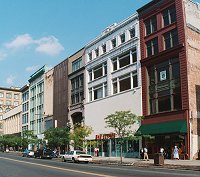Give Downtown a Future While Respecting City's PastJanuary 30, 2004 By Sean Kirst Waste and Thrift are longtime sentinels on the main street of our city.
Since the late 1800s, the smiling gargoyles - one smug, one wild- eyed - have stared down from the facade of 325 S. Salina St., which was originally built as the Syracuse Trust Co. bank. But Waste and Thrift's sleepless vigil may be coming to an end. Syracuse officials have proposed leveling the old bank and at least portions of seven other buildings on that block, part of an elaborate plan to keep Excellus BlueCross BlueShield and roughly 1,000 jobs downtown. The subsequent construction, and Excellus expansion, would swallow up the old Woolworth's building - whose art deco facade and trademark clock survive beneath an ugly wraparound Rite Aid sign. Also lost would be a Warren Street building that houses Lemp Jewelers & Silversmiths, a downtown institution. The structure would be replaced with a new building for Excellus. In a city scarred by decades of often thoughtless demolition, it might seem that historians would be up in arms. But it is a mark of civic need and hard-earned strategic wisdom that few preservationists are ready to start a war. Many advocates of sensitive urban design prefer to wait for the chance to study whatever final proposal comes from City Hall. Even so, several preservationists quietly wonder if the city can be persuaded to give ground on one key point: If the buildings have to go, at least save the best facades. "It would be good to maintain the historic look of Salina Street," said Dennis Connors, curator of history at the Onondaga Historical Association. "Short of (saving the facades), you hope the look could be replicated in any new design." For Connors, an activist historian who's never afraid to say his piece, that is a relatively cautious position. It reflects the political reality for preservationists. Excellus means jobs, which mean downtown vibrancy. To be seen as too strident in protecting these particular buildings would not help in other looming preservation battles - notably if Destiny USA starts to ripple into the North Side. Almost two years ago, Mayor Matt Driscoll first proposed hollowing out the string of buildings along the 300 block. Driscoll's original concept called for saving the facades and demolishing the buildings behind them. They would be replaced with a multi-use complex of apartments, commercial space and indoor parking that would give Excellus the parking space it needs to stay downtown. In other words, the historic "streetscape" of South Salina Street would remain the same. That's changed. In the latest incarnation of the plan, the city wants to demolish most of the buildings in their entirety, facades and all. Charles Everett, director of city operations, said civic engineers continue to study the physical and financial feasibility of saving "all or part" of the buildings. But the city has to be "feasible and practical," Everett said. "Our ultimate goal," he said, "is saving the 1,000 jobs." The price tag for demolition and new construction would be roughly $21 million, Everett said, with $2.5 million coming through a federal Housing and Urban Development loan. The use of that money has automatically touched off a review by the state Office of Parks, Recreation and Historic Preservation, since several buildings targeted for going down are eligible for listing on the National Register of Historic Places. The state sounds none too thrilled about widespread demolition on a historic thoroughfare. "All of our conversations up to now are in preliminary stages, but obviously our goal would be to minimize any loss to those historic buildings," said Cathy Jimenez, a spokeswoman for state parks. "We hope to work out something that would be compatible with the buildings and the space around it." Similar concerns are voiced by Elizabeth Kammell, director of the Community Design Center at Syracuse University. What the situation underlines, Kammell said, is the need for an architecture review board in Syracuse - a panel with real teeth that could study the effects of proposed construction or demolition on the fabric of the city. As for the old Syracuse Trust, the owners of 325 S. Salina St. are awaiting a decision. David Peatfield said he and his wife, Nellie, bought into the building in 1986. "I'm a real estate appraiser, and I've been involved in litigation and condemnation my whole career," Peatfield said. "I would rather not move, but this is reality." At one point, he said, the city was telling him he had to leave by March. Peatfield wishes he would receive some kind of update, but he said there's no point in getting angry at the city. "I've been around (development) so long, I'm not going to get emotionally involved in my own building," he said. Still, the gargoyles above his front door have paid silent witness to great change in Syracuse. They've looked down on Civil War veterans and passengers on trolley cars. They were there during the hard years of the Great Depression. And their frozen smiles were most appropriate last spring, when the championship Syracuse University basketball team passed under Waste and Thrift. They belong downtown. So does Excellus. A great city makes this work. Sean Kirst is a columnist with The Post-Standard. His columns appear Mondays, Wednesdays and Fridays. Call him at 470-6015 or e-mail him at citynews@syracuse.com © 2004 The Post-Standard. |
